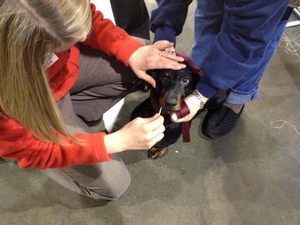I founded this company in 2012 with a single vision, to raise the bar regarding canine genetic testing. Since then, Paw Print Genetics (PPG) has tested more than 200,000 dogs and has provided the most comprehensive menu of tests for inherited diseases and traits across more than 350 breeds of dog. We have helped more than 34,000 customers gain access to genetic knowledge to help them improve their breeding program.
Today is National DNA Day – the day we celebrate the successes of the human genome project. The human genome was completed in 2003 and this opened the door to the sequencing of other animal genomes. With knowledge of the dog genome, which was published in 2005, researchers are now able to identify the DNA changes (called mutations or variants) that contribute to hundreds of traits and diseases in dogs. Once these variants have been identified, we can use this knowledge to develop tests to identify these DNA changes in your dogs.
The unraveling of the dog genome has not only allowed discoveries of single gene mutations but has offered the opportunity to identify and better understand the complexities that exist for some traits and diseases. No ...









